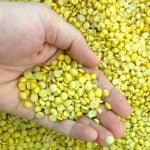U.S. food processing firm Conagra Brands is open to selling its share of North America’s largest milling company.
Sean Connolly, Conagra’s chief executive officer, was asked during a Nov. 12 session at J.P. Morgan’s U.S. Opportunities Forum in Miami what his thoughts were on Ardent Mills.
“We’re open-minded in the future with that business, whether or not it remains part of us or not,” he said.
Read Also

Alberta agriculture minister faces recall petition
The number of approved recall petitions has risen to nine for Premier Danielle Smith’s United Conservative Party caucus after Monday’s confirmation to Alberta’s chief electoral officer.
Dating back to the joint venture’s creation in 2014, Conagra and Cargill have each held 44 per cent of Ardent Mills, while U.S. co-operative CHS owns the remaining 12 per cent.
Ardent Mills operates 30 wheat mills, a durum mill and a rye mill in the United States, where it controls 28 per cent of the milling market.
Ardent has the capacity to mill 21,240 tonnes of flour per day in that market. Ardent’s biggest competitor is ADM Milling Co., with 11,725 tonnes of capacity, according to Milling & Baking News’ Grain and Milling Annual 2026 publication.
Ardent’s Canadian facilities include mills at Mississauga, Montreal and Saskatoon.
Connolly said it is not lost on Conagra that Ardent stands apart from the company’s other assets because it is a branded, “pure play” company that is part of a joint venture.
“It’s a different animal,” he said.
However, it has been a good profit generator for the company.
“Listen, it has been a very nice hedge during the volatile times since COVID, and it has performed extremely well,” he said.
Connolly noted that while Conagra might be open to the idea of selling its share in Ardent, it would not be an easy transaction.
“Don’t assume that it’s a snap of the finger to kind of exit a joint venture. It’s more complicated than that,” he said.
“When joint ventures are built, they are often built so that they are going to be there for a lasting period of time, otherwise it can be hard to draw joint venture partners into it.”

















 MEMBERSHIP
MEMBERSHIP